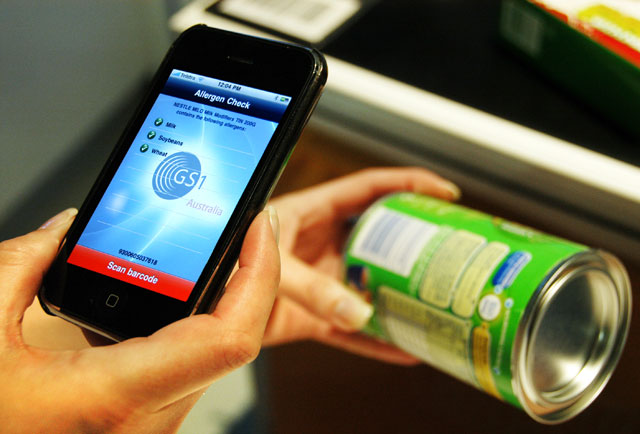Barcode administrator GS1 Australia has teamed up with Deakin University and Nestle to develop an iPhone application that will shortly give allergy sufferers the ability to scan supermarket barcodes to determine what they can safely eat.
Information about potentially risky substances such as wheat, egg, peanuts and shellfish is often found on product labels – but Deakin associate professor Caroline Chan pointed out the information was sometimes so small consumers could barely read it – let alone understand it.
In contrast, product barcodes are universal keys that often provide detailed product information such as weights, volumes, packaging material and price – but their use is currently limited to supermarket inventory control and to settle purchases at the cash register.
“We wanted to really harness all this information on the bar-coding system and team it up with detailed product information provided by Nestlé to give consumers a tool that had the potential to improve their health and raise public awareness,” said Chan.
GS1 Australia is the non-profit organization which administers the GS1 system – a global standard for barcodes that facilitates international trading – in Australia.
GS1 chief information officer Steven Pereira said the group had recently taken responsibility for development of the app and was currently working to make it compatible with Apple’s iPhone user interface guidelines so that it could be listed in the company’s App Store. It has commissioned an iPhone design specialist to assist with the task.
The app will see new fields added to GS1’s barcode database where manufacturers will be able to add extended product information about their offerings – with Nestle being the first trial cab off the rank.
The manufacturers often had the information available in their own databases anyway, said Pereira, as they were required to do so under food standards regulations.
The allergy application is also seen as the first stage for GS1’s strategy to extend its mobile offerings – Pereira also sees potential to add other information to the group’s product database – for example, regarding nutrition, or the carbon footprint of certain products. And the group is also planning to extend its offering to other mobile phone platforms.
Globally, GS1 is looking into adjacent offerings such as electronic coupons that could be delivered by supermarkets in-store via mobile platforms.
Pereira agreed the sorts of solutions of which the iPhone app is an example were able to come about because of GS1’s position as a non-profit working with multiple manufacturers to pool their data — there’s no commercial agenda. The group is also working, for example, on similar applications of its data with the Department of Health and Ageing to help address obesity concerns.
Image credit: GS1


While a good idea, the overhead of keeping up with changing manufacturers labelling is going to be huge.
And with people then becoming reliant on the app to give the all clear, it’s not actually teaching them the terms that they need to look out for.
Aaron
Comments are closed.